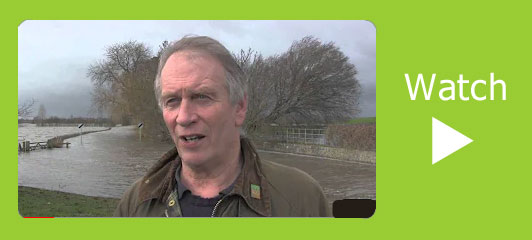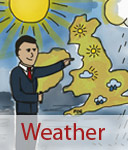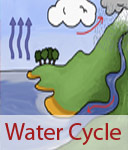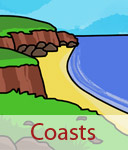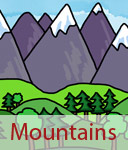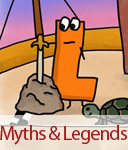
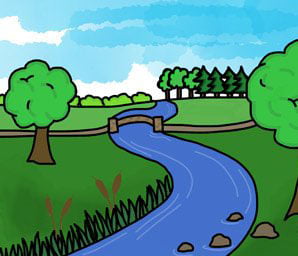
Rivers and floods
Rivers and floods for kids KS2 learning at Primary School. Primary Homework help with rivers and floods. Facts about rivers, and information about floods and why they happen.
What are the features of a river?
Water Flow - A river is a natural waterway that keeps flowing from one place to another. It is like a long, winding stream of water that moves continuously. Just like a road for cars, a river is a "road" for water!
Source - Every river starts at a special place called its source. This is usually high up in the mountains or hills, where the water first appears. It might be a spring, a melting glacier, or even a small rain puddle. It's like the river's birthplace.
Channel - A river has a path called a channel, which is like a route that the water follows. The channel can be wide or narrow, straight or curvy, depending on the shape of the land it flows through.
Banks - The edges of a river are called its banks. They are like the river's borders or sides. You can imagine them as the walls that hold the river in place. Sometimes, the banks are steep, and at other times, they may be gently sloping.
Tributaries - Along its journey, a river may meet smaller streams or rivers that join it. These smaller streams are called tributaries. Think of them as the river's friends that come together to make it stronger!
Meanders - Rivers often create curves and bends as they flow. These curves are called meanders. They can make the river look like a snake or a zigzag line on a map. Sometimes, meanders can even form beautiful loops called oxbow lakes.
Rapids and Waterfalls - In some places, the land might become steep or rocky, causing the river to flow faster and more forcefully. When this happens, you might see rapids, which are areas with rough, tumbling water. And if the land suddenly drops, the river plunges down to create a waterfall, making a spectacular sight!
Delta - Towards the end of its journey, a river may split into many smaller streams and form a wide, triangular area near its mouth, where it meets a lake, sea, or ocean. This area is called a delta. Deltas are like the river's final destination, where it spreads out and delivers the water and sediment it has been carrying.
How do rivers change over time?
Rivers can change a lot over time. These are things that can cause a river to change.
Erosion - One of the ways rivers change is through erosion. Erosion is when the water of the river gradually wears away the land and rocks along its banks and bed. It's like the river giving the land a gentle "scrubbing." Over time, this erosion can make the river wider and deeper.
Sediment - As the river flows, it picks up tiny pieces of rocks, sand, and soil called sediment. The river carries this sediment with it. Sometimes, the river may deposit or drop the sediment it is carrying, creating small islands or sandbars. This process is like the river's way of leaving behind some of the things it has picked up.
Floods - Sometimes, when there is a lot of rain or when snow melts quickly, the river can overflow its banks and cause a flood. Floods can change the landscape around the river. They can deposit new sediment, create new channels, and even change the shape of the river itself. Floods can be powerful and can reshape the land.
Meanders and Oxbow Lakes - Remember those bends or curves called meanders? Well, over time, meanders can change too. The river might erode the outer bank of a meander, making the curve wider. Eventually, the river might take a shortcut, leaving behind a curved lake called an oxbow lake. It's like the river making its own unique shape.
Deltas - As mentioned before, when a river meets a lake, sea, or ocean, it forms a delta. Deltas are constantly changing too. The river carries sediment and deposits it at the delta, making the land grow. Over time, the river might change its course and create new channels within the delta, shaping the landscape.
Human Influence - Rivers can also change because of human activities. People might build dams across rivers to control the flow of water or create reservoirs. Dams can change the river's speed and direction. People might also divert or change the path of a river to meet their needs. These human actions can greatly impact how a river changes over time.
Facts about rivers
- The world's longest river is the Nile, stretching approximately 6,650 kilometres (4,130 miles) through northeastern Africa.
- The deepest known river is the Congo River in Africa, with some parts reaching depths of over 220 meters.
- The longest river in the UK is the River Severn. It flows through both England and Wales, stretching approximately 354 kilometres (220 miles) in length.
Plants & animals in UK rivers
Rivers in the UK are like special homes for many different kinds of plants and animals. Water plants provide a safe place for water creatures to live. Plants and flowers grow along the riverbanks and give insects and birds a cosy home.
UK rivers are home to many animals and fish. One fascinating fish found in UK rivers is the Atlantic Salmon. It's a special fish that can swim long distances and comes back to the same river where it was born to lay its eggs. There's also the Brown Trout, a fish that loves clean and fresh water. And have you heard of the European Eel? These slippery creatures travel far and wide to find the perfect place to breed and grow.
In the rivers, you might also spot some amazing amphibians like the Common Frog. They hop around near the water, especially during the breeding season when they lay their eggs. And keep an eye out for the Common Toad too! They come out at night and live near rivers, ponds, and other watery places.
Otters are fantastic swimmers and live in rivers, hunting for fish and playing in the water. And there's the Water Vole, a cute little creature that makes its home in the riverbanks, munching on plants and enjoying a swim now and then.
Rivers attract many birds too. The Kingfisher is a beautiful bird loves that rivers because it can find yummy fish to eat. And don't forget about the Grey Heron. You might see it standing very still near the water, waiting patiently to catch its fishy meal.
Rivers are like busy communities filled with different plants and animals. They provide homes, food, and a safe place to live. Exploring the rivers can be an exciting adventure where you can discover the wonders of nature!
How can we look after our rivers?
Taking care of our rivers is important to keep them clean, healthy, and safe for all the plants and animals that live in them. Here are some simple ways we can look after our rivers:
Keep it Clean - It's important not to throw trash or litter into rivers or along their banks. Always use bins to dispose of our waste properly. If you see any litter near a river, you can even help by picking it up and throwing it away. This way, we can keep the river clean and prevent pollution.
Save Water - We can help our rivers by conserving water. Remember to turn off the tap while brushing our teeth or lathering our hands with soap. Taking shorter showers and using water wisely in our homes helps to save water, which means more water will stay in the rivers for the plants and animals that need it.
Plant Trees - Trees are like superheroes for rivers! They help prevent soil erosion, provide shade, and even filter out pollution. You can participate in tree planting activities or talk to adults about planting trees near rivers. By doing so, we can create healthier environments for rivers and their inhabitants.
Be Kind to Wildlife - When we visit rivers, it's important to observe and appreciate the wildlife from a respectful distance. We should avoid disturbing or harming the animals or their habitats. Feeding ducks or other waterfowl might seem fun, but it's best to let them find their natural food sources.
Remember, rivers are precious habitats that support countless plants and animals. By being responsible and taking small actions, we can all make a big difference in protecting and preserving these beautiful waterways.
What is flooding?
Flooding happens when there is too much water in an area, like a river or on land. It occurs after heavy rain, quick snow melting, or when a dam breaks. The extra water cannot soak into the ground or flow away quickly, so it spreads and covers places that are usually dry.
Flooding can be a big problem. It can damage homes, buildings, and roads. People may have trouble moving around, and it can be dangerous for plants and animals too.
 Rain & Floods
Rain & FloodsLearn about the different types of floods and how they occur.
How can we stop floods from happening?
Stopping floods from happening is not always possible, but we can take steps to reduce their impact and keep ourselves safe. Here are some simple ways to prevent floods:
Build and Maintain Flood Barriers - Constructing strong walls or levees (natural walls) along rivers and streams can help contain the water during heavy rainfall.
Improve Drainage Systems - Properly designed and maintained drainage systems can help water flow away quickly, reducing the risk of flooding. Cleaning and clearing debris from drains, gutters, and ditches also help water to move freely.
Protect Natural Wetlands - Wetlands act like sponges, absorbing water during heavy rains and slowly releasing it afterward. Looking after our wetlands is important because they can naturally reduce flooding by storing extra water.
Avoid Building in Flood-Prone Areas - When constructing homes or buildings, it's essential to avoid areas that are known to flood frequently. Floodplains and low-lying areas near rivers are more likely to experience flooding, so it's best to build in safer locations.
Plant Trees and Vegetation - Trees and plants help absorb water and stabilize the soil, reducing erosion and the risk of flooding. Encouraging tree planting and preserving existing vegetation near rivers and streams can be helpful in flood prevention.
 What is dredging?
What is dredging?Britain has been hit by the most severe flooding (2014) in 90 years and water levels are still rising. But what is dredging and will it help?
 Thames Barrier - London
Thames Barrier - LondonVisit London biggest defence towards floods. To learn more about how the barrier works visit the government website for the Thames Barrier.
 Stop Disasters Game
Stop Disasters GameLearn the risks posed by natural hazards and manage your resources. Build schools, hospitals, housing and defences to protect the local population.

